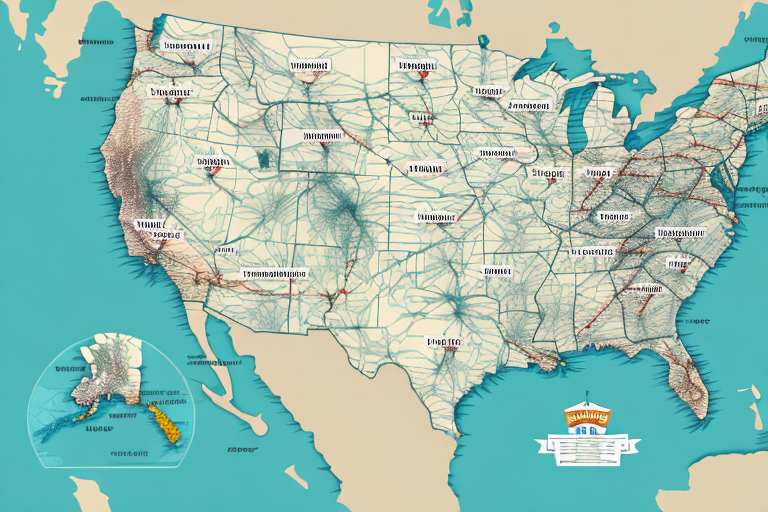Understanding UPS Shipping Rates from New Jersey to Minnesota
Shipping rates can significantly impact your business, especially if you regularly ship items from New Jersey to Minnesota. Understanding how UPS calculates shipping rates and the factors that influence these rates can help you make informed decisions, optimize your shipping costs, and enhance customer satisfaction. In this article, we explore the intricacies of UPS shipping rates and provide strategies to reduce your shipping expenses.
Why Understanding UPS Shipping Rates is Important
Grasping how UPS determines shipping rates enables you to choose the most cost-effective and efficient shipping services based on your business needs. Without this knowledge, you risk overspending on shipping or compromising delivery speed, which can affect your bottom line and customer satisfaction.
Additionally, comprehending UPS shipping rates allows you to accurately calculate shipping costs for your customers. This precision helps prevent overcharging or undercharging for shipping, maintaining your business's reputation and profitability. By investing time in understanding UPS shipping rates, you ensure informed shipping decisions that offer the best possible service to your customers.
How UPS Calculates Shipping Rates
UPS determines shipping rates based on several factors, including package weight and dimensions, shipping origin and destination, service level, and any additional services required. The four primary components influencing UPS shipping rates are:
- Package weight and dimensions
- Package value
- Destination and origin
- Shipping service level and additional services
The weight and size of your package are critical in determining UPS shipping rates. Heavier and larger packages incur higher shipping costs. UPS utilizes dimensional weight pricing for larger packages, which considers both the package's size and weight to calculate the shipping rate effectively.
The origin and destination of the package also significantly affect shipping rates. Rates may vary based on the distance between the two locations, as well as any applicable customs or import/export fees. UPS provides international shipping services to over 220 countries and territories, each potentially influencing the rate differently.
According to UPS's latest [Annual Report](https://investors.ups.com/annual-reports), efficient rate calculation is crucial for maintaining competitive pricing and operational efficiency.
Factors that Affect UPS Shipping Rates
Several factors can influence the cost of shipping with UPS, including:
- Package weight and dimensions
- Shipping origin and destination
- Shipping service level
- Additional services such as insurance and signature confirmation
- Peak season and holiday surcharges
- Currency conversion fees for international shipments
The nature of the items being shipped also plays a role in determining shipping rates. For instance, hazardous materials or items requiring special handling may attract additional fees. Moreover, the timing of your shipment can affect the rate; expedited or same-day shipping options are typically more expensive than standard shipping. To ensure you receive the best value, compare rates and services across different shipping providers, considering both cost and service quality.
Comparison of UPS Shipping Rates to Other Carriers
When comparing shipping rates among carriers, it's essential to recognize that each carrier has its own rate structures and additional fees, which can significantly impact your final shipping costs. While UPS may sometimes have higher rates compared to other carriers like FedEx or USPS, it offers a broader range of delivery options and services, including guaranteed delivery times and comprehensive package tracking.
UPS is renowned for its reliable and timely deliveries, making it a preferred choice for businesses shipping time-sensitive or high-value items. According to a [2023 industry survey](https://www.forbes.com/sites/forbestechcouncil/2023/04/25/shipping-trends-2023/), UPS consistently ranks high in terms of reliability and customer satisfaction.
Understanding the Difference Between Residential and Commercial Shipping Rates
Residential and commercial shipping rates typically differ, with residential rates being higher due to the increased complexity and cost associated with residential deliveries. Understanding this distinction is vital for minimizing shipping costs based on delivery type.
Different carriers may have varying definitions of what constitutes a residential or commercial delivery. For example, a home-based business might be classified as a residential delivery by some carriers, while others may consider it commercial. It's crucial to confirm with your carrier how they define these categories to select the appropriate shipping service and avoid unexpected fees.
Tips for Reducing Your UPS Shipping Costs
Implementing the following strategies can help reduce your UPS shipping costs:
- Select the right shipping service based on your needs and budget
- Optimize package weight and dimensions to minimize shipping costs
- Utilize discounts offered by UPS or through a business account
- Employ shipping software to automate and optimize shipping fees
- Explore alternative shipping methods, such as drop-shipping and parcel consolidators
Scheduling pickups instead of dropping off packages at UPS locations can save both time and money. Additionally, using eco-friendly packaging materials like recycled boxes and biodegradable packing peanuts not only reduces shipping costs but also supports environmental sustainability.
How to Package Your Items for Optimal Shipping Rates
Proper packaging is essential for minimizing shipping costs. Follow these guidelines to package your items effectively:
- Use a sturdy box that appropriately fits the items being shipped
- Carefully wrap fragile or delicate items with suitable packaging materials
- Fill empty spaces in the box with packing peanuts or other void fillers
- Clearly and accurately label each package
Reducing the weight of your packages without compromising the safety of the contents is crucial, as carriers charge based on both size and weight. Utilize lightweight packaging materials and remove any unnecessary items or packaging. Consolidating multiple items into a single package can also lead to significant cost savings.
How to Choose the Best UPS Service Level for Your Needs
Selecting the appropriate UPS service level is key to balancing cost and delivery requirements. When choosing a service level, consider factors such as your delivery timeline, destination, package dimensions, and any additional services required.
For high-value items, opting for services that include extra insurance or enhanced tracking may be beneficial. When shipping internationally, research customs requirements and restrictions to ensure compliance and avoid unforeseen charges.
Understanding the Role of Distance in UPS Shipping Rates
The distance between the shipping origin and destination is a pivotal factor in determining UPS shipping rates. Generally, longer distances result in higher shipping costs. When selecting a shipping service level, consider how the distance may affect both the cost and delivery time.
Package weight also influences the rate; heavier packages incur higher costs regardless of distance. Accurately weighing your packages and selecting the appropriate shipping service level helps prevent unexpected expenses. UPS offers various packaging options designed to reduce shipment weight, potentially lowering your shipping costs.
How to Use Technology to Optimize Your UPS Shipments
Leveraging technology can significantly enhance the efficiency of your UPS shipments. Implementing shipping software can automate tasks, streamline shipping processes, and provide real-time package tracking. Integrating this software with your e-commerce platform or order management system can further optimize your shipping operations and reduce errors.
Utilizing data analytics allows you to examine shipping data to identify trends and patterns, enabling informed decisions about your shipping strategy. For example, you might discover that specific shipping methods or carriers are more cost-effective for certain products or destinations, allowing you to adjust your processes to save time and money.
Common Mistakes to Avoid When Using UPS for Shipping
To optimize your UPS shipping and minimize costs, avoid the following common mistakes:
- Selecting the wrong shipping service level for your needs
- Providing inaccurate package measurements or weights
- Neglecting to utilize available discounts or promotions
- Overlooking essential details, such as signature confirmation or insurance
- Poor packaging leading to shipment damage or loss
Additionally, improper labeling can lead to delivery errors. Ensure each package includes clear and accurate labels with the recipient's name, address, and phone number, as well as your return address. For international shipments, include all necessary customs forms and documentation to prevent delays or additional fees.
By avoiding these pitfalls and implementing the strategies discussed, you can enhance your UPS shipping efficiency, reduce costs, and ensure your shipments reach their destinations safely and on time.




















